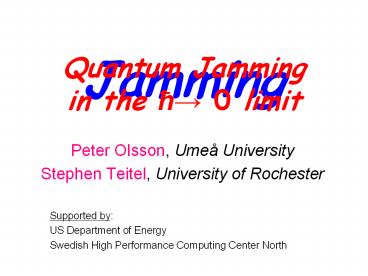Jamming - PowerPoint PPT Presentation
Title:
Jamming
Description:
Stephen Teitel, University of Rochester. Supported by: US Department of Energy. Swedish High Performance Computing Center North. Quantum Jamming ... – PowerPoint PPT presentation
Number of Views:34
Avg rating:3.0/5.0
Title: Jamming
1
Jamming
Quantum Jamming in the h? 0 limit
- Peter Olsson, Umeå University
- Stephen Teitel, University of Rochester
- Supported by
- US Department of Energy
- Swedish High Performance Computing Center North
2
what is jamming?
transition from flowing to rigid in condensed
matter systems
3
the structural glass transition
long range correlations
short range correlations
solid
liquid
shear stress
solid shear modulus
liquid shear viscosity
?????? correlations
glass
4
the structural glass transition
glass
liquid
equilibrium transition? (diverging length
scale) dynamic transition? (diverging time
scale) no transition? (glass is
just slow liquid)
one of the greatest unresolved problems of
condensed matter physics
transition from flowing to rigid but disordered
structure thermally driven
5
sheared foams
polydisperse densely packed gas bubbles
thermal fluctuations negligible
critical yield stress
foam has shear flow like a liquid
foam ceases to flow and behaves like an elastic
solid
transition from flowing to rigid but disordered
structure shear driven
6
granular materials
large weakly interacting grains
thermal fluctuations negligible
grains flow like a liquid
grains jam, a finite shear modulus develops
the jamming transition
transition from flowing to rigid but disordered
structure volume density driven
7
This false color image is taken from Dan Howell's
experiments. This is a 2D experiment in which a
collection of disks undergoes steady shearing.
The red regions mean large local force, and the
blue regions mean weak local force. The stress
chains show in red. The key point is that on at
least the scale of this experiment, forces in
granular systems are inhomogeneous and
itermittent if the system is deformed. We detect
the forces by means of photoelasticity when the
grains deform, they rotate the polarization of
light passing through them. Howell, Behringer,
Veje, PRL 1999 and Veje, Howell, Behringer, PRE
1999
8
isostatic limit in d dimensions
number of force balance equations Nd (for
repulsive frictionless particles)
isostatic stability when these are equal
Z is average contacts per particle
seems well obeyed at jamming ?c
9
flowing ? rigid but disordered
conjecture by Liu and Nagel (Nature 1998)
jamming, foams, glass, all different aspects of a
unified phase diagram with three axes ? ?
temperature ???? ? ? volume density ???? ? ?
applied shear stress (nonequilibrium
axis)
point J is a critical point the epitome of
disorder
jamming transition point J
critical scaling at point J influences behavior
at finite T and finite ?.
understanding ?? 0? jamming at point J may
have implications for understanding the glass
transition at finite ?
here we consider the ?????? plane at T 0 in 2D
10
shear viscosity of a flowing granular material
if jamming is like a critical point we expect
11
(Durian, PRL 1995 (foams) OHern, Silbert, Liu,
Nagel, PRE 2003)
model granular material
bidisperse mixture of soft disks in two
dimensions at T 0 equal numbers of disks with
diameters d1 1, d2 1.4
for N disks in area LxLy the volume density is
interaction V(r) (frictionless)
overlapping ? harmonic repulsion
overdamped dynamics
12
simulation parameters
Lx Ly N 1024 for ? lt 0.844 N 2048 for??
0.844 ?t 1/N, integrate with Heuns
method total shear displacement 10, ranging
from 1 to 200
depending on N and??
finite size effects negligible (cant get too
close to ?c)
animation at ? 0.830 ? 0.838 lt ?c ? 0.8415
? 10-5
13
results for small ? 10-5 (represents ??? 0
limit, point J)
as N increases, ??????? vanishes continuously at
?c ? 0.8415
smaller systems jam below ?c
14
results for finite shear stress ?
15
scaling about point J for finite shear stress ?
scaling hypothesis (2nd order phase
transitions) at a 2nd order critical point, a
diverging correlation length ?? determines all
critical behavior quantities that vanish at the
critical point all scale as some power of
??? rescaling the correlation length, ? ? b?,
corresponds to rescaling
?? b?1/? , ? b????? , ????
b????
16
scaling law
choose length rescaling factor b ? ??????
17
scaling collapse of viscosity ?
point J is a true 2nd order critical point
18
correlation length
regions separated by ? are anti-correlated
motion is by rotation of regions of size ?
19
scaling collapse of correlation length ?
??diverges at point J
20
phase diagram in ??? plane
21
conclusions
point J is a true 2nd order critical point
critical scaling extends to non-equilibrium
driven steady states at finite shear stress
? ????? in agreement with proposal by Liu and
Nagel correlation length diverges at point J
diverging correlation length is more readily
observed in driven non-equilibrium steady
state than in equilibrium state finite
temperature?































